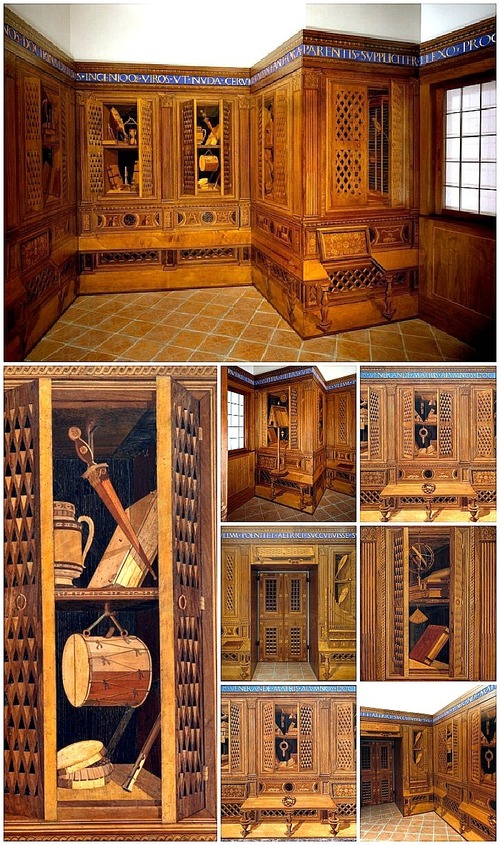
Within the vast halls and imposing galleries of New York’s Metropolitan Museum, well-hidden from the casual visitor, resides the finest Italian Renaissance room in America. The studiolo from Gubbio (e.c. Umbria), in Le Marche region of Italy and the former southern capital of the Montefeltro lands, is a marvel of the Renaissance woodworker’s skill.
This studiolo, which tricks the eye with its seeming three-dimensionality of fictive cabinets, objects you could grab, and projecting benches, proved to be the final architectural triumph created for Federico da Montefeltro (1422–1482)
Richly decorated in intarsia work, it was a small bookroom and place of private contemplation, the setting for intimate discussions between the ruler and a privileged visitor. The construction of Federico’s first studiolo, still in situ in the Urbino palace, began in 1476. From this time, the architect Francesco di Giorgio Martini was in charge of all of Federico’s construction projects.
In dramatically expanding his father’s modest Gubbio residence, Federico had extended it toward the local cathedral while leaving a cathedral plaza between the buildings. This constrained the eastern wall in an eccentric angle, and the studiolo, installed within the odd angle of this wall, thereby acquired its disproportionate, rhomboid shape.
Like its kin, the Gubbio studiolo is a marvel of inlaid woodwork, a triumph of the intarsiatore, the artisan in inlay. Many types of wood are required—spindle-wood, bog oak, cherry, walnut, pear and mulberry—including wood stained by fungus, producing a polychrome palette; these permit the full development of patterns and colors that inform the illusionistic results of three-dimensional depth, shadows and perspective. Two elaborately coffered ceilings, in gold and polychrome, crown the main section and the window alcove. The blank walls above the intarsia wainscoting once held allegories of the liberal arts and portraits of the Famous Men whom Federico emulated.
Created in the Florentine workshop of the brothers Giuliano and Benedetto da Maiano, the studiolo was installed in Gubbio from 1480 until 1483. The final panels, installed after Federico’s death, reference Guidobaldo, but virtually all the panels reflect Federico’s life, interests and achievements. The intarsia panels “read” clockwise from the left of the doorway. The prime viewing site is in the center, facing the long wall, with one’s back to the window alcove; the Order of the Garter dominates the view. The viewer’s ideal height, 5-foot-6, incidentally tells us how tall Federico was.
Federico’s personal military, scientific and literary interests parade before us: fictive cabinets partially ajar display arms and armor, armorials, scientific devices, musical instruments and scores, documents and writing tools, caged songbirds and many, many books. Some items spill out of the cabinets or rest on equally fictive benches, while others recede into the shadows. The Latin inscriptional frieze extols the merits of approaching Learning with humility. Light comes from the principal window in the alcove and from two eyebrow windows high up in the same “eastern” wall. A patterned, tiled floor completes the ensemble. The setting mimics the shapes and orientation of the now-bare stone room in Gubbio.
Read More
See on bookofjoe.com
via Tumblr http://italianentertainment.tumblr.com/post/41438648073
